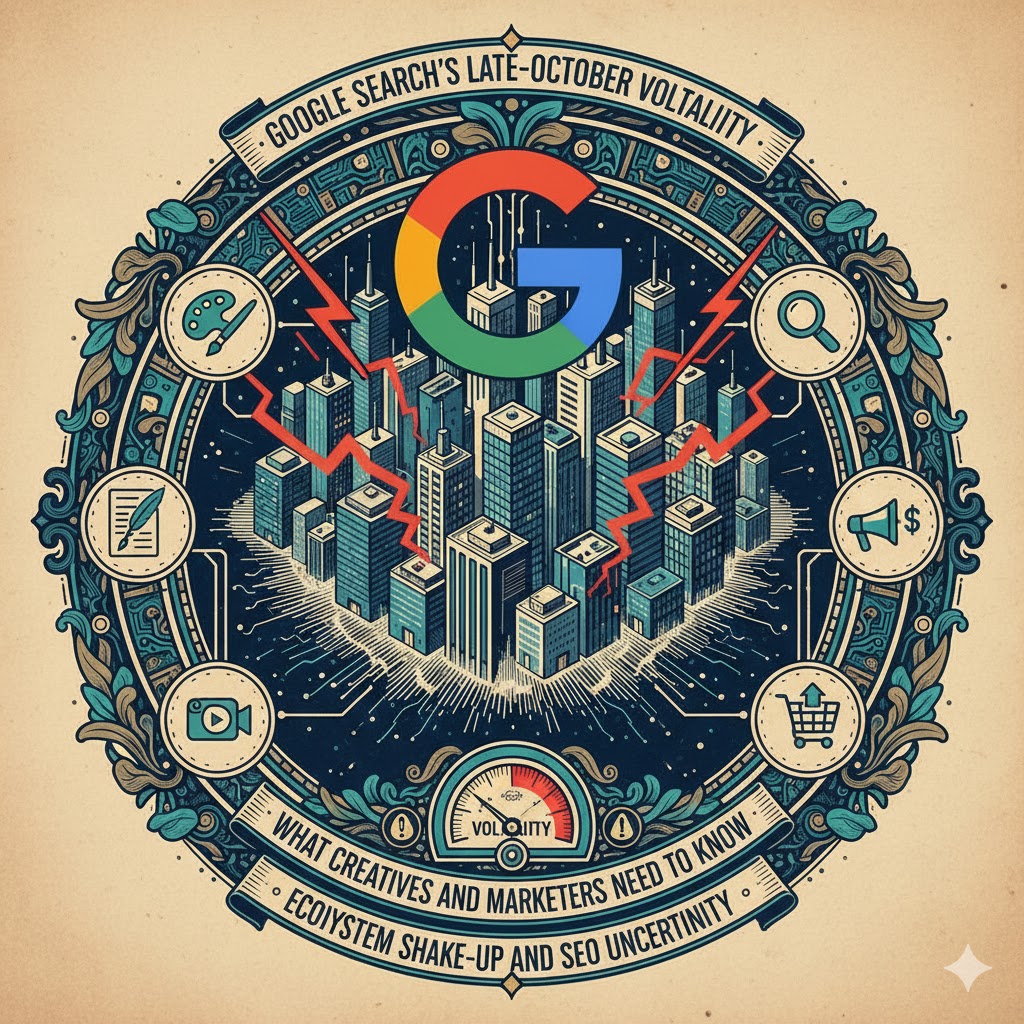When Google’s search results suddenly reshuffle, anyone who lives by clicks—be it content creators, filmmakers promoting work, or creative entrepreneurs—feels the tremor. In late October 2025, a wave of unconfirmed ranking swings left many site owners staring at analytics in disbelief. Some saw traffic plunge by more than 40 % overnight, only to rebound hours laterseroundtable.com. Others noticed unusual surges. With no official word from Google, what caused the disruption and how should creatives respond?
Key takeaways
- Significant ranking turbulence on 28 October — multiple SEO tools and forum chatter reported a spike in volatility around this dateppc.land.
- Localized impact — traffic dips were especially pronounced in the U.K. and U.S., with some sites reporting a 42 % drop in UK traffic before levels snapped backppc.landseroundtable.com.
- Ad layout changes likely played a role — Google had recently introduced a consolidated “Sponsored results” section that pushes organic listings lower and may have diverted clicks from top rankingsblog.googleppc.land.
- Measurement got harder — earlier in September, Google disabled the
&num=100parameter used by rank‑tracking tools, forcing services to recalibrate and muddying datasearchengineland.com. - No confirmed algorithm update — Google’s last official core update finished rolling out in July 2025searchengineland.com. The October swings were unannounced and likely the result of smaller tests or interface shifts rather than a full update.
What happened on 28 October?
Barry Schwartz of Search Engine Roundtable reported on 29 October that he was seeing unusual “rumblings” in both SEO communities and tracking dashboardsseroundtable.com. Webmasters on forums like WebmasterWorld described dramatic traffic drops: one UK publisher said their Google traffic was down 42 % all dayseroundtable.com. Another noted that U.S. and UK visits disappeared until 10 AM, when traffic suddenly snapped backseroundtable.com. These anecdotes were supported by data: at least thirteen monitoring services—including Semrush, MozCast, Wincher and Algoroo—showed elevated volatility around 28 Octoberppc.land.
Interestingly, the pattern was not universal. Some site owners saw traffic spikes instead of declines. Others experienced nothing unusual. Such disparities point away from a broad core algorithm change and toward targeted experiments, bugs or interface tweaks that affected specific regions and query types.
Why the volatility matters to creatives and marketers
Ad changes are shifting the click landscape
On 13 October 2025, Google rolled out a new “Sponsored results” block that groups text ads under a single, persistent labelblog.google. The design includes a “hide sponsored results” button, allowing users to collapse adsblog.google. 9to5Google noted that this update makes ads more obvious—and more avoidable9to5google.com. However, until users hide the section, the grouped ads consume prime real estate above the organic results. SEO consultant Cyrus Shepard observed that even branded queries, where sites still ranked #1, suffered traffic declinesppc.land. For creators relying on organic exposure, this means a strong ranking may no longer guarantee clicks.
Data quality took a hit
On 18 September, Google confirmed that it no longer supports the &num=100 URL parameter used to request 100 results per pagesearchengineland.com. Many rank‑tracking platforms depended on this parameter; its removal forced them to make ten separate requests for the same data, increasing costs and introducing noisesearchengineland.com. As a result, volatility charts may look more erratic even when actual ranking changes are modest. This complicates diagnosing whether a traffic change stems from an algorithm shift or simply from measurement artefacts.
An unconfirmed event amid an unstable year
The October swings occurred in a year already marked by two confirmed core updates. The first, the March 2025 core update, ran from 13 March to 27 March and lasted about 14 dayssearchengineland.com. Google said its goal was to make results more relevant and advised creators to focus on helpful content rather than technical fixessearchengineland.com. The second, the June 2025 core update, began on 30 June and completed around 17 July—a rollout of roughly 16 days and 18 hourssearchengineland.com. Google again emphasised that there are no specific actions needed aside from producing satisfying, people‑first contentsearchengineland.com.
Between these confirmed updates, SEOs observed other unannounced volatility spikes in April and mid‑Octoberseroundtable.com. Yet Google issued no communication about them. The late‑October tremor follows this pattern: it’s noticeable to practitioners but not large enough for Google to label as a core update.
Navigating the new SERP landscape
For creatives and digital marketers, the October volatility is a reminder that search is a moving target. Here are practical strategies to stay resilient:
- Monitor click‑through rates, not just rankings. With ads occupying more screen space, a #1 organic ranking may yield fewer clicks. Watch Search Console’s CTR metrics and adjust titles and meta descriptions to entice users.
- Stay aware of interface changes. Test the “hide sponsored results” button yourself to see how it alters the page. Use multiple devices and geolocations to understand where your audience might see ads versus organic results.
- Produce people‑first content. Google’s advice during the March and June core updates stressed helpful, trustworthy content as the best defence against volatilitysearchengineland.comsearchengineland.com. Articles that serve readers—whether a film‑maker’s blog, a tutorial or a product review—are more likely to weather algorithm tweaks.
- Diversify your traffic sources. Don’t rely solely on Google. Build an email list, engage on social platforms and explore emerging discovery channels. That way, sudden ranking shifts won’t cut off your entire audience.
- Use multiple data tools. Given the limitations introduced by the removal of the 100‑results parameter, cross‑check performance using Search Console, analytics platforms and independent rank trackers. Look for consistent trends rather than isolated anomalies.
Conclusion
The late‑October 2025 search shake‑up illustrates how changes beyond algorithm updates—like ad layouts and measurement tools—can impact organic traffic. In this case, many creatives experienced sudden drops as Google tested or adjusted its systems, but the effects were short‑livedseroundtable.com. Understanding the broader context—recent ad changes, measurement disruptions and the cadence of official updates—helps demystify these episodes. By focusing on authentic, audience‑focused content and diversifying your traffic sources, you can continue to thrive in the unpredictable search landscape.










